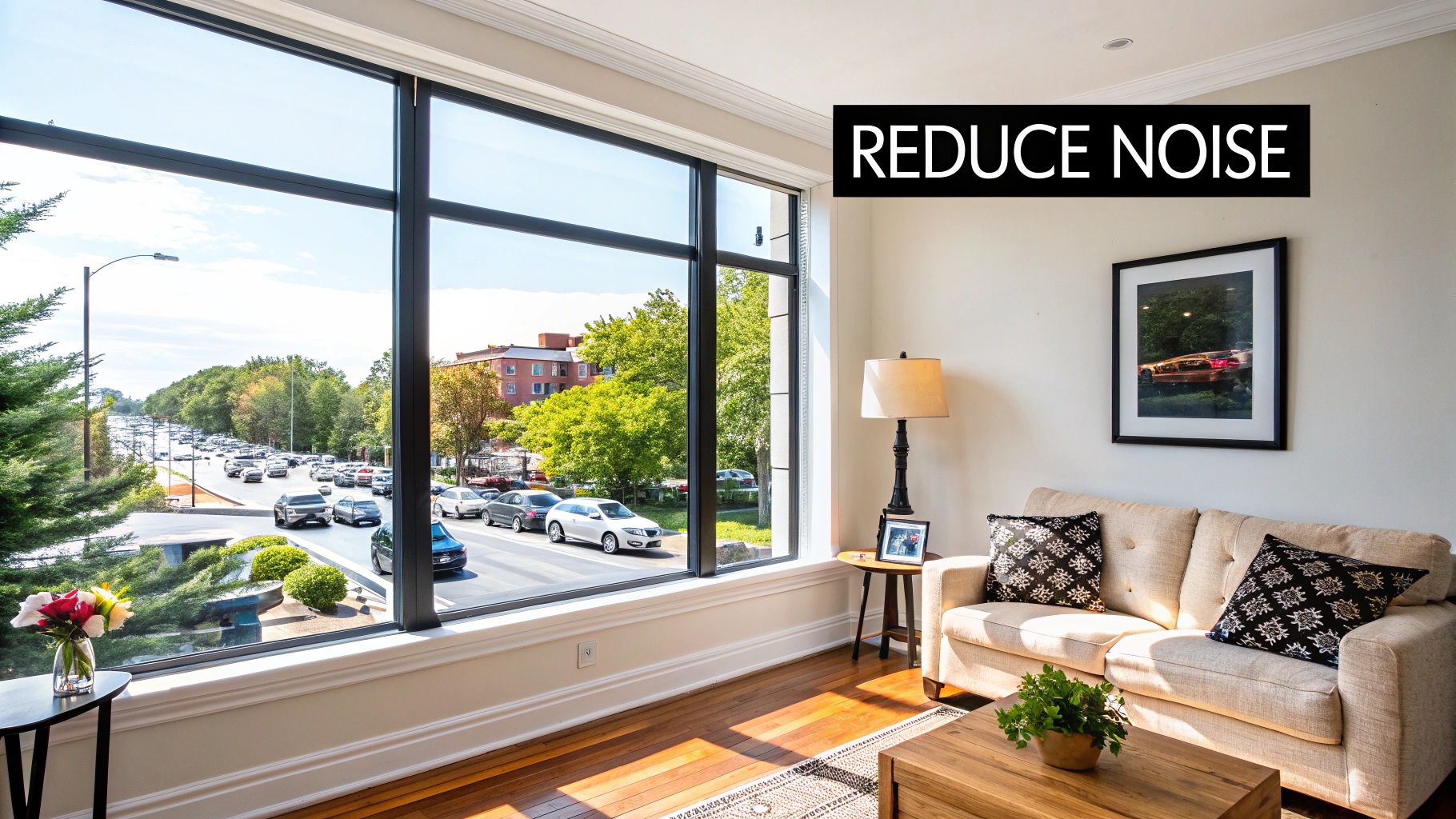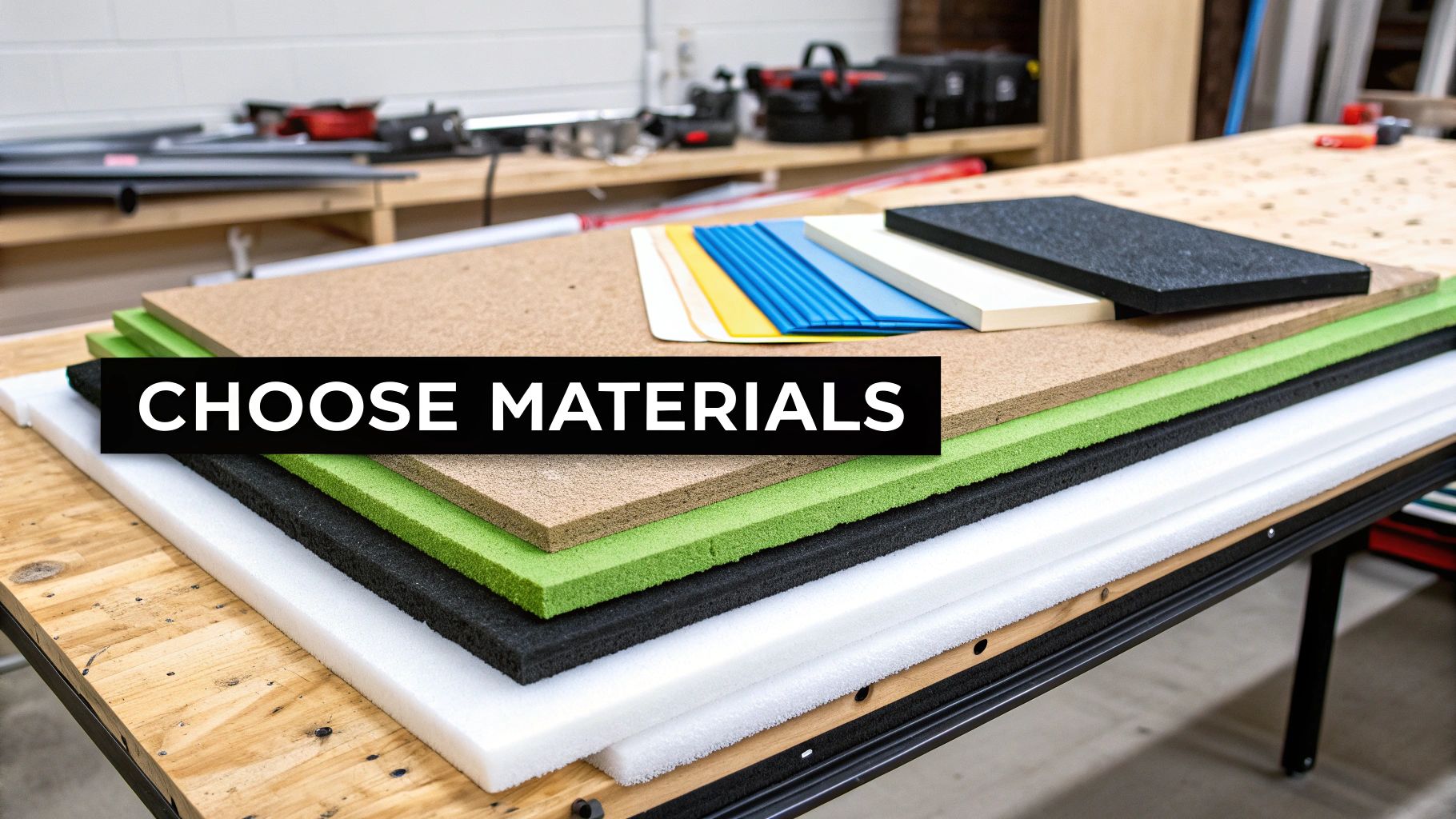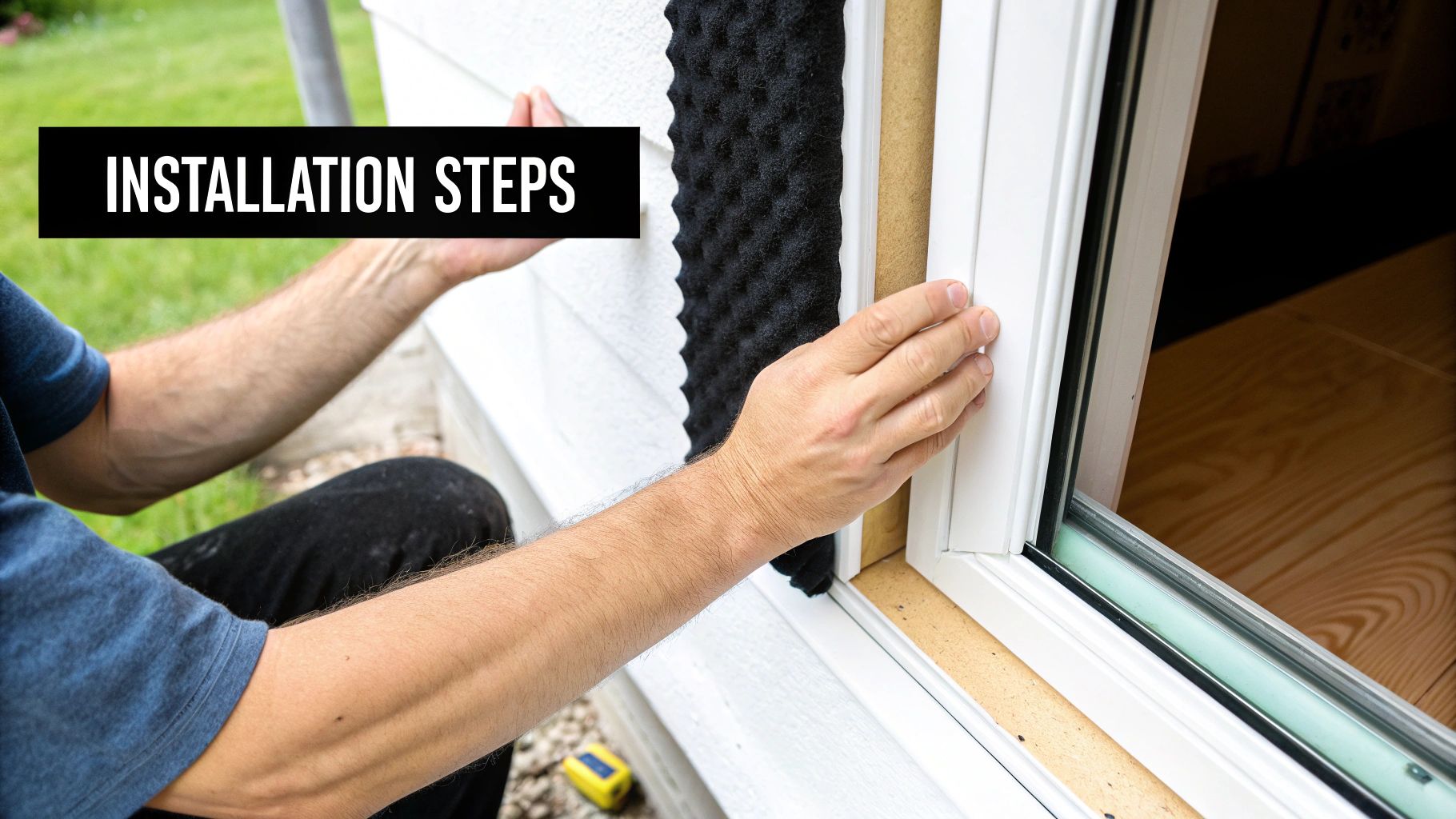DIY Window Soundproofing: A Homeowner's Guide to Quieter Living
- Johann Reardon

- Jul 18
- 12 min read
That constant hum of traffic, the neighbor's dog that barks at everything, the late-night city sounds that just won't quit—they're more than just annoying. They genuinely chip away at your peace, focus, and most importantly, your sleep. Are you looking for effective ways to reclaim your quiet without a massive renovation?
The good news is that true DIY window soundproofing is well within reach. By tackling the most common culprits—sealing air gaps, adding mass with heavy curtains, and using specific materials to absorb sound waves—you can create a more peaceful home environment. For those tougher noise challenges, professional-grade solutions can offer a permanent fix.
Why Your Home's Quiet Is Worth Protecting

When you're trying to figure out where all that noise is coming from, look no further than your windows. They are, by far, the biggest weak point in your home's defense against the outside world. That constant drone from a busy street might feel like background noise you've gotten used to, but it has a real, measurable impact on your well-being.
As more of us find ourselves living closer together, the demand for quieter homes is skyrocketing. The global soundproof windows market was valued at around $1.3 billion in 2022 and is expected to more than double by 2033. It's not surprising when you consider that nearly 80% of the U.S. population now lives in urban areas, making effective sound control a modern necessity.
Key Insight: It's shocking, but even a tiny 1% gap around your window frame can let in as much as 30% of outside sound. Sealing those gaps is always the first, most critical step. It delivers immediate and noticeable results.
Common Noise Sources and Their Impact
Noise pollution isn't just one thing; it's a mix of different sounds coming from all directions. Understanding what you're up against can help you find the most effective solution. Here’s a quick look at some common culprits we see homeowners struggling with.
Noise Source | Common Problem | Effective Solution Area |
|---|---|---|
Traffic & Sirens | High-pitched, intermittent sounds that disrupt sleep and focus. | Sealing gaps, adding mass with thick drapes or shades. |
Neighbors & Pets | Mid-frequency sounds like voices, music, or barking. | Absorbing materials, acoustic panels, heavy curtains. |
Lawn Mowers & Leaf Blowers | Low-frequency droning that penetrates standard windows easily. | Layering solutions, window inserts, or professional-grade treatments. |
By identifying the type of noise, you can better target your soundproofing efforts where they’ll make the biggest difference.
When you’re dealing with moderate noise levels, layering different solutions is your best bet. For instance, combining weatherstripping with thick, noise-reducing shades creates a surprisingly powerful sound barrier. We walk you through this approach in our complete guide to quieter living with noise-reducing shades.
For many homeowners, the goal is to find that sweet spot between effectiveness and aesthetics. And while DIY is a fantastic starting point, sometimes you need a bit more power. This is where professional-grade products and expert advice can make all the difference.
As a family-owned business right here in San Diego, [Home Blinds & Floors](https://www.homeblindsandfloors.com/) has been helping homeowners navigate these exact choices for years. We offer free in-home consultations to find that perfect balance between a peaceful home and a beautiful interior, providing personalized service from the initial assessment to the final installation. We’re here to help protect your home's tranquility.
Your First Line of Defense: Sealing Air Gaps
If you’re starting a DIY window soundproofing project, the biggest and most immediate wins come from tackling the most obvious culprit: air gaps. Sound is lazy; it travels on air. Any crack or opening around your window frame is basically a superhighway for noise to drive right into your home.
You could hang the thickest, most expensive curtains money can buy, but if there's a gap, noise will sneak right past them. It's like trying to bail out a boat with a hole in the bottom. Plugging those holes is your first, most effective line of defense. It's a low-cost, high-impact fix that you'll notice right away. Before you even think about more involved solutions, this is where you have to start.
Finding and Sealing The Leaks
First things first, you need to play detective and find the leaks. On a windy day, this is easy—just run your hand along the window frame and feel for drafts. Another great trick is the "light test." At night, have someone stand outside with a powerful flashlight and shine it all around the edges of the window. Inside, you'll see every little spot where light—and sound—is getting through.
Once you’ve mapped out the problem areas, you have two go-to tools for the job:
Acoustic Caulk: This isn't your standard painter's caulk. Acoustic caulk is a specialized, non-hardening sealant designed to stay flexible for years. This is crucial because your house naturally shifts and settles. Standard caulk will just get brittle, crack, and reopen the very gaps you worked so hard to fill. Use this for any stationary gaps, like between the window frame and the wall itself.
Weatherstripping Tape: For the moving parts of your window—the sash or where the bottom of the window meets the sill—weatherstripping tape is the answer. It’s a self-adhesive foam or rubber tape that creates a tight compression seal when the window is closed, blocking both air and sound. The best part is, it still lets you open and close your window smoothly.
The image below gives you a solid idea of what to look for when you're getting ready to tackle a window project, highlighting the key measurements that make or break its effectiveness.

As you can see, getting precise measurements is fundamental, whether you're sealing gaps or planning a bigger upgrade. Properly sealing these weak points not only quiets things down but also gives your home's energy efficiency a nice boost.
Speaking of measurements, if you're thinking about adding new window treatments to help with sound, getting the fit just right is critical. We've put together a handy resource to help you learn how to measure for blinds with our expert installation guide. A perfect fit means better sound reduction.
Pro Tip: When you're applying acoustic caulk, less is more. Don't just smear a thick layer over the crack. The goal is a small, clean bead pushed deep into the gap. For a truly professional look, grab a caulk finishing tool. It will give you a clean line that practically disappears.
While sealing gaps is a game-changer, sometimes it's just the first step. If you've done all this and still need more peace and quiet, a professional consultation can really help. Our experts at Home Blinds & Floors are skilled at diagnosing those stubborn noise issues and finding solutions that work perfectly with your home’s look and feel.
Using Window Treatments for Sound Absorption

Now that you’ve plugged the most obvious air gaps, it's time to deal with the sound waves that still find their way inside. Soft surfaces are your biggest ally in this fight. They absorb and muffle sound instead of letting it bounce around the room, which is why the right window treatments are such a powerful—and stylish—tool for your DIY window soundproofing project.
Think of it like adding pillows to an empty, echoey room. The more plush materials you add, the less sound can reverberate. That same idea applies directly to your windows.
The Power of Cellular Shades
Cellular shades, often called honeycomb shades, are engineered for much more than just good looks. Their unique honeycomb-shaped pockets trap air, creating an insulating barrier that works against both temperature fluctuations and irritating noise. I’ve found this design is especially good at dampening high-frequency sounds, like street chatter or screeching tires.
When you're shopping for cellular shades, keep these features in mind:
Double-Cell Construction: A single-cell shade is good, but a double-cell design adds a whole extra layer of air pockets. This seriously boosts their sound-dampening power.
Light-Filtering vs. Blackout: It’s a simple matter of physics. Blackout fabrics are denser and heavier, making them a much better choice for absorbing sound.
A Perfect Fit: This is non-negotiable. A snug fit inside the window frame is critical. Any gaps on the sides will let sound sneak right past, making the shade far less effective.
For homeowners here in San Diego, getting that perfect, gap-free fit is why custom solutions are so valuable. The custom blinds and shades we create at Home Blinds & Floors are made-to-measure, ensuring you get the maximum acoustic performance that off-the-shelf products just can't deliver.
Layering with Heavy Curtains
Another fantastic strategy is to hang thick, heavy curtains. This isn't just about the fabric type; it's about density and proper installation. For a truly effective and luxurious solution, dense fabrics like velvet curtains are a game-changer, absorbing a significant amount of noise while adding a touch of comfort.
To get the best results, look for curtains made from heavyweight materials—velvet, suede, or tightly woven thermal fabrics work wonders. For an extra punch, layer a blackout liner behind your decorative curtain. You’re essentially adding more mass, creating a formidable barrier against outside noise.
The demand for quieter homes has created a booming market. The global soundproof doors and windows market is projected to hit roughly $1.33 billion by 2025, a clear sign that people are tired of noise pollution and are actively seeking peace.
This trend shows just how many of us are looking for the tranquility that good soundproofing can bring. While your DIY efforts make a huge difference, the best outcomes almost always come from combining multiple strategies.
Working with a family-owned expert like Home Blinds & Floors means you get tailored advice on which treatments will solve your specific noise problems and look beautiful in your home.
Advanced DIY Soundproofing Techniques for Stubborn Noise
Alright, so you’ve sealed the gaps and even hung some heavy-duty curtains, but that relentless street noise is still finding its way in. If you're dealing with stubborn sounds—think low-frequency traffic rumbles or the sharp bark of the neighbor's dog—it’s time to bring out the bigger guns.
Don't worry, we're not talking about a full-blown construction project. These are more advanced, but still very doable, DIY window soundproofing methods for when the basics just don't cut it.

One of the most powerful moves you can make is to add a second barrier using a custom-fit acrylic window insert. It’s like giving yourself a second window pane, but without the cost and mess of a full replacement.
This extra pane creates a pocket of dead air between it and your original window. That air gap is a fantastic sound insulator. Sound waves lose a huge amount of their energy trying to push through that space, which means far less noise makes it into your room.
Installing an Acrylic Window Insert
The secret to making this work is getting a perfectly snug, airtight fit. You’ll need to be meticulous with your measurements. Measure the height and width of your interior window frame at a few different points, just to be safe. Most companies that sell these custom-cut inserts have great guides on their websites to walk you through it.
Once you have the insert, the installation is refreshingly straightforward.
Prep the Area: Give your existing window and the inside of the frame a good cleaning. You want the surface to be totally free of dust and grime.
Add the Edging: Your kit will likely include a flexible silicone or rubber edging. You just fit this around the entire perimeter of the acrylic sheet. This is what creates that all-important airtight seal.
Pop It In: Gently bow the acrylic sheet just enough to press it into the window frame. The tension from the edging will snap it into place and hold it firm.
It's amazing how much of a difference a perfect seal makes. An air gap as small as 1% of the window's total area can let in up to 30% of the outside noise. This is exactly why a perfectly fitted window insert is such a game-changer—it closes that final weak link.
Bring in Acoustic Panels
Here's another trick I’ve seen work wonders: tackling the sound after it’s already in the room. Sound waves love to bounce off hard surfaces like drywall, wood floors, and even large panes of glass. This creates echoes that make the noise feel louder and more intrusive.
Placing acoustic panels on the wall next to your window can solve this. These aren't just decorative; they're made of sound-absorbing materials like dense felt or mineral wool designed to trap and deaden sound waves. They stop noise from reflecting and amplifying inside your space.
While this technique doesn't block sound from getting through the window itself, it dramatically improves the room's acoustics, making the whole space feel quieter and more peaceful. For a truly powerful one-two punch, combine a window insert with good insulation. You can check out some of the [best window insulation for winter solutions](https://www.homeblindsandfloors.com/post/8-best-window-insulation-for-winter-solutions-of-2025) that also happen to have fantastic sound-dampening properties.
Knowing When to Call a Professional
While DIY methods can make a remarkable difference, there are times when even the best home-spun solution just won't cut it. You reach a point where you have to be honest with yourself. If you’re dealing with severe, persistent noise—like the constant drone of a nearby highway, an airport flight path, or non-stop commercial activity—it's a clear sign you need to shift your strategy from sound muffling to true sound blocking.
This is where the line between a weekend project and a professional investment becomes crystal clear. For those intense noise issues, you need high-performance, permanent solutions that a simple curtain or film can't provide.
When DIY Isn't Enough
Let's be real: even the most dedicated DIY window soundproofing efforts can significantly quiet things down, but they often struggle against low-frequency sounds. These are the deep rumbles from trucks or bass-heavy music that seem to vibrate right through the structure of your home.
Think of it this way: DIY solutions are great at managing moderate, day-to-day sounds. Professional installations, on the other hand, are engineered to combat severe acoustic challenges head-on. As our cities get louder, the demand for truly effective noise control is only growing.
The global market for soundproofing windows was valued at around $4.8 billion in 2023 and is projected to climb to $8.5 billion by 2032. This growth reflects a worldwide push for quieter living spaces amidst rising urban noise. You can discover more about this trend and its drivers.
For these more serious situations, you'll want to explore options built from the ground up for sound insulation. Products like double- or triple-pane windows and solid-core plantation shutters provide a level of performance that temporary fixes simply can't match.
If you're weighing your options for high-end treatments, our guide can help you decide between plantation shutters versus blinds and which is best for you.
The Value of an Expert Consultation
Knowing which high-performance product is right for your home can feel overwhelming. This is where getting an expert opinion is invaluable. A professional can properly assess your specific noise problem, evaluate your existing windows, and recommend the most effective solution for your budget and home’s style.
Deciding between DIY fixes and professional-grade solutions can be tough. This table breaks down the key differences to help you figure out the best path for your home and budget.
DIY vs Professional Window Soundproofing
A comparison to help you decide which approach is right for your home and budget.
Feature | DIY Solutions | Professional Solutions |
|---|---|---|
Best For | Moderate noise like distant traffic, neighborhood chatter, or barking dogs. | Severe, persistent noise like highways, airports, train tracks, or construction. |
Cost | Low to moderate. Materials can be purchased for a relatively small upfront cost. | Higher initial investment, but a long-term, permanent solution. |
Effectiveness | Good for reducing mid-to-high frequency sounds. Less effective on low-frequency rumbles. | Excellent sound blocking across all frequencies, including deep, low-frequency noise. |
Installation | You do it yourself. Can be time-consuming and requires careful attention to detail. | Handled by trained experts, ensuring a perfect fit and maximum performance. |
Products | Acoustic caulk, weatherstripping, soundproof curtains, window inserts. | Double/triple-pane windows, laminated glass, acoustic-grade plantation shutters. |
Longevity & Value | Often temporary or semi-permanent. May not add significant property value. | Permanent installation that adds tangible value and appeal to your home. |
Ultimately, while DIY is a great starting point, a professional solution offers a definitive, long-term fix for serious noise pollution, ensuring peace of mind for years to come.
At Home Blinds & Floors, this is exactly what we specialize in. As a family-owned business, we provide free in-home consultations to help homeowners in San Diego and Orange County identify the true source of their noise problems. Our team ensures you get more than just a product—you get a complete, flawlessly installed solution that guarantees lasting peace and quiet. This professional touch transforms a frustrating problem into a permanent, valuable improvement for your home.
Your DIY Window Soundproofing Questions Answered
Even with the best plan, questions can arise during a home improvement project. Let's tackle some of the most common ones we hear about DIY window soundproofing to help you get back to enjoying a quieter home.
What is the most effective DIY window soundproofing method?
The most effective approach is layering multiple solutions. Always start by sealing air gaps around the window frame with acoustic caulk and weatherstripping—this provides the biggest impact for the lowest cost. From there, add a layer of sound-absorbing material. Combining heavy blackout curtains with custom-fit cellular shades is a powerful strategy that blocks and muffles sound waves effectively.
How do I soundproof my windows without replacing them?
You have several excellent options that don't require replacement. Start by sealing all air leaks with acoustic caulk. Then, add mass and absorption with heavy, soundproof curtains or install custom-fit cellular shades. For more significant noise, an acrylic window insert creates an insulating air gap that dramatically reduces sound transmission.
Are there any window treatments specifically for soundproofing?
Yes, certain window treatments are designed with acoustics in mind. Cellular (or honeycomb) shades are a top choice because their air-trapping pockets provide excellent sound dampening. Solid-core plantation shutters near me are also highly effective, as their dense material blocks sound waves. For the best results, look for custom window coverings to ensure a perfect fit with no gaps for sound to leak through.
What if I still hear noise after trying these DIY fixes?
If you've sealed gaps and added sound-absorbing treatments but noise persists, you're likely facing severe or low-frequency sound (like highway traffic). It could also mean the sound is flanking, or traveling through walls and floors. At this point, it's wise to get an expert opinion. A free in-home consultation from Home Blinds & Floors can help pinpoint the real source of the problem and suggest professional solutions that will actually work, saving you from throwing more time and money at the wrong issue.
In Summary: Your Path to a Quieter Home
In conclusion, achieving a quieter home through DIY window soundproofing is entirely possible. Start with the basics: meticulously seal all air gaps around your windows with acoustic caulk and weatherstripping. Then, layer on sound-absorbing materials like heavy curtains or cellular shades. For more persistent noise, advanced DIY solutions like acrylic inserts can make a significant difference.
However, for severe noise pollution, professional-grade solutions offer a permanent and highly effective fix. Working with a trusted local expert ensures you get the right products and flawless installation for lasting peace and quiet.
Ready to explore high-performance window treatments that offer superior sound reduction and style? The expert team at [Home Blinds & Floors](https://www.homeblindsandfloors.com/) provides personalized consultations to help you find the perfect solution for a quieter, more peaceful home.

.avif)

Comments